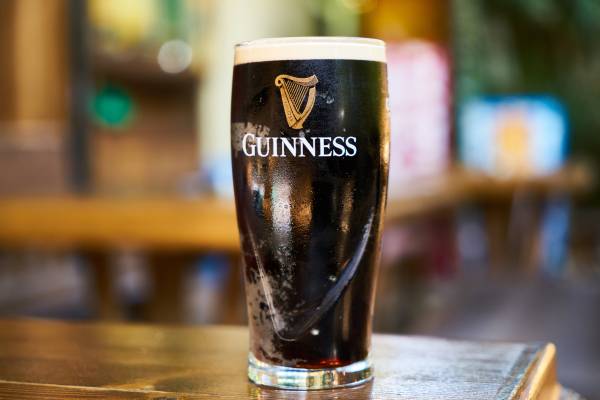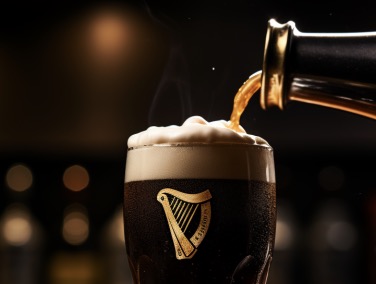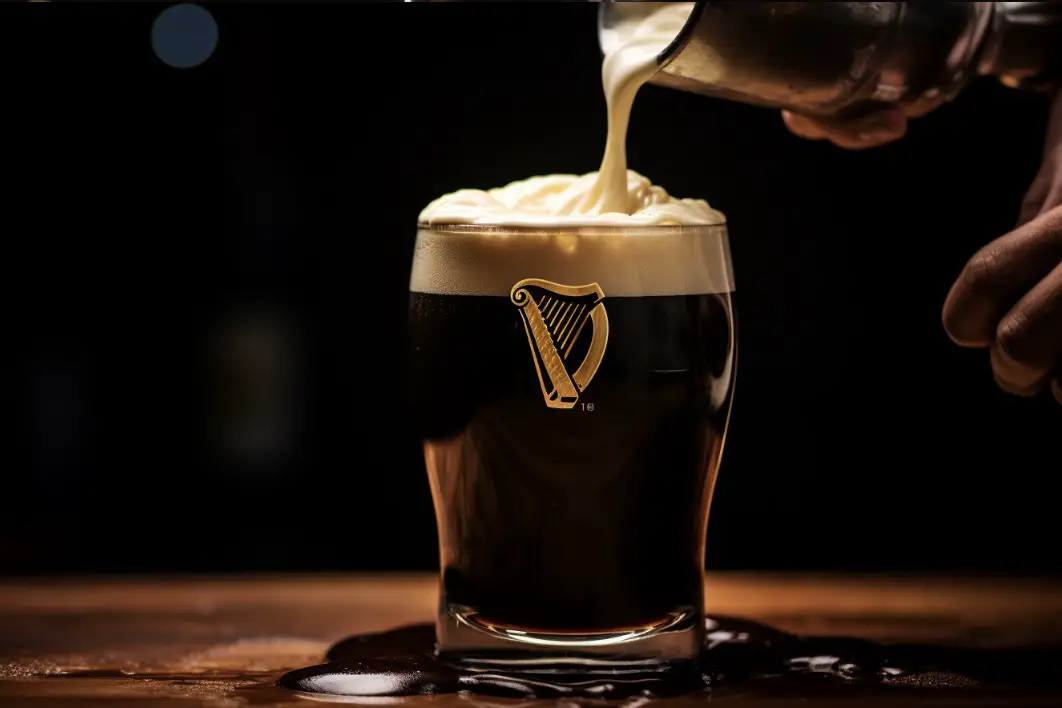Yes, Guinness is carbonated but also “nitrogenated”. However, the carbonation in Guinness is quite different from most other beers.
While most beers are carbonated with carbon dioxide (CO2), Guinness is “carbonated” with a mixture of CO2 and nitrogen gas (N2), which is what gives it its famous creamy texture and cascading bubbles.
In this blog post, we’ll discuss the unique carbonation process in Guinness and how it affects the overall drinking experience.
The History of Guinness and its Carbonation
Guinness, which was first brewed in 1759 in Dublin, Ireland, has a long and storied history. The iconic beer is known for its dark, rich flavor and its creamy, velvety texture. This distinct mouthfeel is a result of the unique carbonation process that sets Guinness apart from other beers.
In the 1950s, Guinness began exploring ways to improve the quality and consistency of their beer. One of the innovations they introduced was the use of nitrogen gas in addition to carbon dioxide for carbonation. This method, known as the Nitro system, was first used in 1959 and has since been adopted by other breweries for their own stouts and ales.
The Science Behind Guinness Carbonation: CO2 vs. Nitrogen Gas
The key difference between the carbonation in Guinness and other beers lies in the type of gas used. While most beers are carbonated with carbon dioxide, Guinness uses a mixture of carbon dioxide and nitrogen gas for carbonation.

Carbon dioxide gas dissolves easily in beer and creates larger bubbles that quickly rise to the surface. This results in a sharp, fizzy mouthfeel that is common in most carbonated beverages.
In contrast, nitrogen gas does not dissolve as easily in beer and forms smaller, more stable bubbles. These tiny bubbles create a smooth, creamy texture in the beer, which is the trademark characteristic of Guinness.
The Nitro System: How Guinness is Nitrogenated
The Nitro system used to carbonate Guinness involves a two-step process. First, the beer is carbonated with a mixture of CO2 and nitrogen gas in the brewery.
Then, the beer is served using a special tap system that forces the beer through a restrictor plate with tiny holes, which further breaks up the gas bubbles and creates a rich, creamy head.
Nitrogen Gas Canisters
One of the challenges in using nitrogen gas for carbonation is that it does not dissolve as easily in beer as carbon dioxide.
To overcome this, Guinness developed a patented device called a widget. The widget is a small, hollow plastic ball that is filled with a small amount of nitrogen gas. This widget is placed inside cans and bottles of Guinness before they are sealed.
When the can or bottle is opened, the sudden change in pressure releases the nitrogen gas from the widget, which then forms thousands of tiny bubbles throughout the beer.
This widget technology has been instrumental in allowing people to enjoy the distinctive creamy texture of Guinness outside of a pub setting.
The Perfect Guinness Pour
Pouring a Guinness properly is essential to achieving the perfect drinking experience. A good pour will result in a beer with a smooth, creamy texture and a thick, long-lasting head.

Here are the steps to pour the perfect pint of Guinness:
1. Hold the glass at a 45-degree angle and open the tap fully
2. Pour the beer until it’s about two-thirds full
3. Allow the beer to settle for a moment, as the nitrogen bubbles cascade downwards and form a creamy head
4. Fill the glass to the top, pouring slowly and straightening the glass as you go, to create a slightly domed head
The Taste and Mouthfeel of Guinness
The nitrogen carbonation in Guinness not only affects the texture of the beer but also its taste. Nitrogen gas is relatively tasteless and odorless, which means it does not affect the flavor profile of the beer. This allows the rich, roasted flavors of the malted barley to shine through.
The creamy mouthfeel created by the nitrogen bubbles also enhances the overall drinking experience. The smooth texture of Guinness can make it seem lighter and more drinkable than other beers with a similar alcohol content, despite its dark color and bold flavor.
What other beers are Nitrogenated?
Apart from Guinness, there are several other beers that are nitrogenated instead of carbonated. Nitrogenation is a process in which nitrogen gas is added to the beer, typically at higher pressure, to create smaller bubbles and a smoother, creamier texture. Here are a few examples of nitrogenated beers:
- Boddingtons: Boddingtons Pub Ale is a popular nitrogenated beer from England. It has a rich, creamy texture and a smooth flavor.
- Murphy’s Irish Stout: Murphy’s is an Irish stout similar to Guinness but with its own distinct character. It is nitrogenated to create a velvety mouthfeel and a creamy head.
- Kilkenny Irish Cream Ale: Kilkenny is another Irish beer that undergoes nitrogenation. It has a creamy texture, a slightly sweet taste, and a smooth finish.
- Left Hand Milk Stout Nitro: This American beer from Left Hand Brewing Co. is nitrogenated and known for its silky smoothness. It features flavors of roasted malt, chocolate, and coffee.
- Young’s Double Chocolate Stout: Young’s Double Chocolate Stout from England is nitrogenated and renowned for its rich, indulgent flavors of chocolate and roasted malt.
- O’Hara’s Irish Stout: O’Hara’s Irish Stout is an Irish nitrogenated beer with a robust flavor profile that includes hints of coffee and dark chocolate.
- Samuel Adams Nitro Project: The Nitro Project by Samuel Adams offers a range of nitrogenated beers, including Nitro Coffee Stout and Nitro White Ale, among others. Each beer is nitrogen-infused to enhance its texture and taste.
These are just a few examples, and there may be other breweries producing nitrogenated beers as well. It’s always worth exploring your local breweries and craft beer bars to discover new nitrogenated options.
Conclusion: The Unique Appeal of Guinness
In conclusion, Guinness is indeed carbonated, but its carbonation process is what sets it apart from other beers.
The use of nitrogen gas in addition to carbon dioxide creates a smooth, creamy texture that has become synonymous with the iconic Irish stout.
Below are 8 fascinating facts about Guinness that you may not have known before reading this article:
1. Guinness is carbonated with a mixture of CO2 and nitrogen gas
2. The Nitro system was first introduced in 1959
3. Nitrogen gas creates smaller, more stable bubbles than carbon dioxide
4. The use of nitrogen gas results in a smooth, creamy texture in the beer
5. Guinness uses a special tap system to serve the beer and create a rich, creamy head
6. The patented widget technology allows for the distinctive texture of Guinness to be enjoyed in cans and bottles
7. Pouring the perfect pint of Guinness requires attention to detail and patience
8. Nitrogen carbonation enhances the rich, roasted flavors of the malted barley
So, the next time you enjoy a pint of Guinness, take a moment to appreciate the unique carbonation process that contributes to its distinctive taste and texture. Cheers!
FAQs
What is the carbonation level in Guinness?
The carbonation level in Guinness is relatively low compared to other beers. It is known for its smooth and creamy texture, achieved through a combination of lower carbonation and the use of nitrogen gas during the brewing process.
Which beer is least acidic?
The acidity of beer can vary depending on the brewing process and ingredients used. Generally, lighter beers such as lagers or pilsners tend to have lower acidity levels compared to darker beers like stouts or porters. However, it’s important to note that the acidity of beer is usually mild and not a major concern for most individuals.
Which beer has less carbonation?
There are several factors that can affect the carbonation level of beer, including the brewing process and style of beer. Generally, lagers tend to have less carbonation compared to ales.
Additionally, beers that undergo longer fermentation periods and are bottle-conditioned often have lower carbonation levels.
However, it’s important to note that carbonation can vary between different brands and individual batches, so it’s always best to check the specific beer’s carbonation level if you’re looking for a less carbonated option.
What is the gas setting for Guinness?
The gas setting for Guinness is typically a mix of nitrogen and carbon dioxide (CO2). This combination creates a smooth and creamy texture, giving Guinness its distinctive taste and appearance.
What is the acidity level of Guinness?
The acidity level of Guinness is relatively low. It has a pH level of around 4.2 to 4.4, which is considered mildly acidic.
Can I use 60 40 gas for Guinness?
No, you cannot use 60/40 gas for Guinness. Guinness requires a specific gas blend called “beer gas” or “nitrogen CO2 mix” which typically consists of 75% nitrogen and 25% carbon dioxide. This blend is essential for creating the smooth and creamy texture that Guinness is known for.




